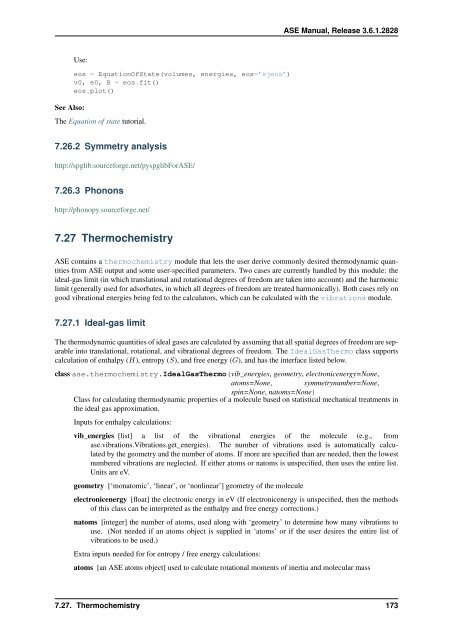ASE Manual Release 3.6.1.2825 CAMd - CampOS Wiki
ASE Manual Release 3.6.1.2825 CAMd - CampOS Wiki
ASE Manual Release 3.6.1.2825 CAMd - CampOS Wiki
Create successful ePaper yourself
Turn your PDF publications into a flip-book with our unique Google optimized e-Paper software.
Use:<br />
See Also:<br />
eos = EquationOfState(volumes, energies, eos=’sjeos’)<br />
v0, e0, B = eos.fit()<br />
eos.plot()<br />
The Equation of state tutorial.<br />
7.26.2 Symmetry analysis<br />
http://spglib.sourceforge.net/pyspglibFor<strong>ASE</strong>/<br />
7.26.3 Phonons<br />
http://phonopy.sourceforge.net/<br />
7.27 Thermochemistry<br />
<strong>ASE</strong> <strong>Manual</strong>, <strong>Release</strong> 3.6.1.2828<br />
<strong>ASE</strong> contains a thermochemistry module that lets the user derive commonly desired thermodynamic quantities<br />
from <strong>ASE</strong> output and some user-specified parameters. Two cases are currently handled by this module: the<br />
ideal-gas limit (in which translational and rotational degrees of freedom are taken into account) and the harmonic<br />
limit (generally used for adsorbates, in which all degrees of freedom are treated harmonically). Both cases rely on<br />
good vibrational energies being fed to the calculators, which can be calculated with the vibrations module.<br />
7.27.1 Ideal-gas limit<br />
The thermodynamic quantities of ideal gases are calculated by assuming that all spatial degrees of freedom are separable<br />
into translational, rotational, and vibrational degrees of freedom. The IdealGasThermo class supports<br />
calculation of enthalpy (H), entropy (S), and free energy (G), and has the interface listed below.<br />
class ase.thermochemistry.IdealGasThermo(vib_energies, geometry, electronicenergy=None,<br />
atoms=None, symmetrynumber=None,<br />
spin=None, natoms=None)<br />
Class for calculating thermodynamic properties of a molecule based on statistical mechanical treatments in<br />
the ideal gas approximation.<br />
Inputs for enthalpy calculations:<br />
vib_energies [list] a list of the vibrational energies of the molecule (e.g., from<br />
ase.vibrations.Vibrations.get_energies). The number of vibrations used is automatically calculated<br />
by the geometry and the number of atoms. If more are specified than are needed, then the lowest<br />
numbered vibrations are neglected. If either atoms or natoms is unspecified, then uses the entire list.<br />
Units are eV.<br />
geometry [‘monatomic’, ‘linear’, or ‘nonlinear’] geometry of the molecule<br />
electronicenergy [float] the electronic energy in eV (If electronicenergy is unspecified, then the methods<br />
of this class can be interpreted as the enthalpy and free energy corrections.)<br />
natoms [integer] the number of atoms, used along with ‘geometry’ to determine how many vibrations to<br />
use. (Not needed if an atoms object is supplied in ‘atoms’ or if the user desires the entire list of<br />
vibrations to be used.)<br />
Extra inputs needed for for entropy / free energy calculations:<br />
atoms [an <strong>ASE</strong> atoms object] used to calculate rotational moments of inertia and molecular mass<br />
7.27. Thermochemistry 173












